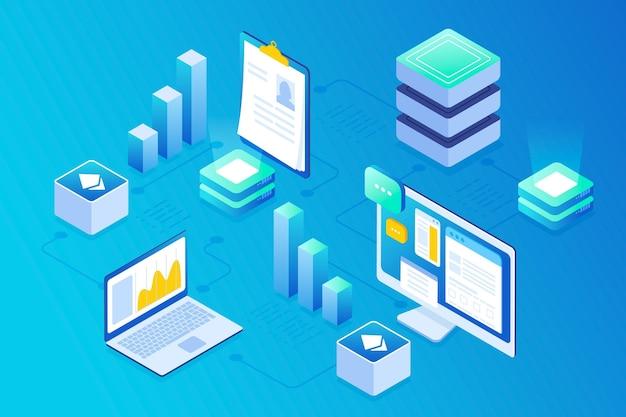Green computing has gained significant attention in recent years as businesses and individuals alike recognize the importance of minimizing their environmental impact. With advancements in technology, it has become essential to seek ways to reduce power consumption, improve energy efficiency, and adopt sustainable practices in the field of computing. In this blog post, we will explore three strategies that can help in the successful implementation of a green computing program.
But first, what is green computing? It is an approach that focuses on utilizing computer resources responsibly to reduce the carbon footprint and promote environmental sustainability. Green computing encompasses various practices such as optimizing energy usage, enhancing hardware and software efficiency, recycling electronic waste, and utilizing renewable energy sources.
In this article, we will delve into three effective strategies that businesses and individuals can adopt to implement a green computing program in 2023. By implementing these strategies, you can not only contribute to a greener planet but also benefit from cost savings and improved operational efficiency. So, let’s explore these strategies in detail and uncover the potential they hold for a sustainable future.

Three Strategies for Implementing a Green Computing Program
In our increasingly technology-driven world, the need for sustainable initiatives has never been greater. Green computing programs offer organizations the opportunity to reduce their environmental impact while also improving the efficiency and longevity of their computing infrastructure. But how exactly can an organization implement such a program? In this article, we will explore three strategies that businesses can employ to kickstart their journey towards greener computing.
Embrace Virtualization and Cloud Technologies
One effective strategy for implementing a green computing program is to embrace virtualization and cloud technologies. By leveraging virtual machines and cloud services, businesses can significantly reduce their energy consumption and hardware requirements. Instead of relying on dedicated physical servers for each application or service, virtualization allows for the consolidation of multiple virtual machines onto a single physical server. This reduces the overall number of servers needed, leading to energy savings and reduced carbon emissions. Additionally, cloud technologies enable organizations to scale their computing resources on-demand, minimizing the need for excess hardware that goes underutilized for extended periods of time.
Optimize Power Management Settings
Another key strategy for green computing implementation is to optimize power management settings across the organization’s computing devices. By configuring computers, laptops, and other devices to enter low-power modes when not in use, businesses can significantly reduce energy consumption. This can be achieved by adjusting settings such as sleep and hibernation timers, as well as enabling power-saving features like automatic display dimming and hard drive power-down. Additionally, organizations can leverage centralized management tools to enforce power management policies across their entire fleet of devices, ensuring consistent energy-saving practices throughout the organization.
Implement Recycling and E-Waste Management Programs
While reducing energy consumption is a crucial aspect of green computing, it’s equally important to address the issue of electronic waste (e-waste). Implementing recycling and e-waste management programs is a third strategy for organizations looking to go green. By establishing processes for the responsible disposal and recycling of outdated or broken electronic equipment, businesses can minimize the environmental impact of their computing infrastructure. This can involve partnering with certified e-waste recycling companies, organizing regular collection drives for employees, or even considering refurbishing options for devices that still have potential life left in them. By diverting e-waste from landfills and ensuring proper recycling processes, organizations can contribute to a more sustainable future.
Implementing a green computing program requires a multifaceted approach that combines technological advancements with responsible waste management. By embracing virtualization and cloud technologies, optimizing power management settings, and implementing recycling and e-waste management programs, businesses can make significant strides towards reducing their environmental impact. Let’s embrace these strategies and pave the way towards a greener, more sustainable future in the realm of computing.

FAQ: Strategies for Implementing a Green Computing Program
Are supercomputers still used
Supercomputers are still widely used in various fields, including scientific research, weather forecasting, and complex simulations. Despite their high computing power, supercomputers have evolved to become more energy-efficient, integrating green computing principles into their design and operation.
Where is green computing used
Green computing is used in various industries and sectors, including government organizations, educational institutions, corporations, and even individual households. It aims to reduce energy consumption, minimize electronic waste, and promote sustainable practices in the use of computers and related technologies.
What are three strategies for implementing a green computing program
-
Optimize Energy Efficiency: One strategy for implementing a green computing program is to ensure energy-efficient practices. This includes using energy-saving settings on computers, utilizing power management features, and upgrading to more energy-efficient hardware components. Adopting virtualization techniques can also reduce the number of physical servers required, saving both energy and resources.
-
Promote Recycling and E-Waste Management: Green computing programs should encourage the proper disposal and recycling of electronic waste. Implementing recycling programs and partnering with certified e-waste recyclers ensures that old devices are recycled responsibly and hazardous materials are handled appropriately.
-
Educate and Engage Users: User education plays a crucial role in promoting green computing practices. Implementing training programs and awareness campaigns can help users understand energy-saving techniques, responsible e-waste disposal, and the overall importance of sustainable computing.
What gaming PC should I buy in 2023
In 2023, some of the best gaming PCs on the market include the “CyberX Ultra 9000,” the “RaptorZ 7000,” and the “StormForge Elite.” These PCs are equipped with high-performance components, advanced cooling systems, and dazzling graphics capabilities to deliver an exceptional gaming experience. Remember to consider your specific requirements, budget, and preferences when selecting the right gaming PC for you.
What are some examples of green computing
There are several examples of green computing practices. These include the use of energy-efficient hardware, virtualization technologies, cloud computing, server consolidation, recycling and responsible e-waste management, and adopting power management settings. Each of these examples contributes to reducing energy consumption and promoting environmental sustainability.
What are the five most powerful computers
As of 2023, the five most powerful computers in the world are:
- Summit – An IBM supercomputer located at Oak Ridge National Laboratory in Tennessee, USA.
- Sierra – A supercomputer located at the Lawrence Livermore National Laboratory in California, USA.
- Sunway TaihuLight – A Chinese supercomputer located at the National Supercomputing Center in Wuxi, China.
- Tianhe-2A – A Chinese supercomputer located at the National Supercomputer Center in Guangzhou, China.
- Fugaku – A supercomputer located at the RIKEN Center for Computational Science in Kobe, Japan.
These powerful machines are used for various purposes, such as scientific research, climate modeling, and simulating complex systems.
How is Green Computing implemented
Green computing can be implemented through a combination of hardware, software, and operational practices. This includes adopting energy-efficient hardware components, optimizing power management settings, using virtualization technologies, implementing cloud computing, promoting responsible e-waste management, and raising user awareness of sustainable computing practices.
What are the objectives of green computing
The objectives of green computing include reducing energy consumption, minimizing electronic waste, promoting resource efficiency, and adopting sustainable practices in the use of computing technologies. By achieving these objectives, green computing aims to minimize the environmental impact of the IT industry while maximizing energy efficiency and preserving natural resources.
What is the best PC ever
Determining the “best” PC ever is subjective and depends on individual needs and preferences. However, some iconic PCs that have left a lasting impact on the industry include the “Apple Macintosh,” the “IBM Personal Computer,” the “Commodore Amiga,” and the “HP Pavilion.” These computers not only excelled in their respective eras but also laid the foundation for technological advancements in the PC industry.
Which is the fastest supercomputer in the world
As of 2023, the fastest supercomputer in the world is Fugaku. Located at the RIKEN Center for Computational Science in Kobe, Japan, Fugaku has set new records in terms of computing power and performance. It is renowned for its ability to perform complex simulations, artificial intelligence research, and analysis of large-scale data sets, making it a vital tool for scientific and technological advancements.
What are two major techniques involved in green computing
Two major techniques involved in green computing are:
-
Virtualization: Virtualization is a technique that allows multiple virtual machines to run on a single physical server. By consolidating servers and optimizing resource allocation, virtualization significantly reduces energy consumption, hardware requirements, and overall carbon footprint.
-
Cloud Computing: Cloud computing involves delivering computing services, such as storage, servers, and applications, over the internet on a pay-as-you-go basis. It promotes resource efficiency by allowing users to access shared computing resources, eliminating the need for individual infrastructure and reducing energy consumption.
What are examples of green technology
Examples of green technology include:
-
Solar Power: Solar panels convert sunlight into electricity, providing a renewable and clean source of energy.
-
Wind Power: Wind turbines harness the power of wind to generate electricity, reducing reliance on fossil fuels.
-
Energy-Efficient Appliances: Energy-efficient appliances, such as LED lights, smart thermostats, and energy-saving refrigerators, minimize energy consumption and reduce environmental impact.
-
Electric Vehicles: Electric vehicles produce lower emissions compared to traditional internal combustion engine vehicles, contributing to a greener transportation sector.
What is power consumption in green computing
Power consumption in green computing refers to the amount of electrical energy consumed by computing devices, data centers, and IT infrastructure. Green computing programs aim to reduce power consumption by adopting energy-efficient hardware, optimizing power management settings, and utilizing virtualization and cloud computing techniques. By minimizing power consumption, green computing mitigates the environmental impact associated with energy-intensive computing activities.
Which fields are supercomputers used in
Supercomputers are used in various fields, including:
-
Scientific Research: Supercomputers assist scientists in conducting complex calculations, simulations, and modeling for research in areas such as climate change, drug discovery, and astrophysics.
-
Weather Forecasting: Supercomputers enable weather prediction models that help meteorologists forecast weather events, track hurricanes, and study climate patterns.
-
Engineering and Design: Supercomputers aid in designing and optimizing complex structures, such as bridges and aircraft, by simulating their behavior under different conditions.
-
Financial Analysis: Supercomputers are used in high-frequency trading, risk assessment, and financial modeling to analyze large volumes of data and make informed decisions.
Supercomputers play a crucial role in advancing scientific knowledge, addressing complex challenges, and accelerating technological advancements across various sectors.
